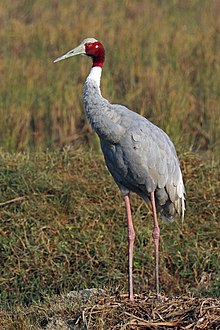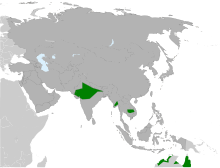Sarus crane
The sarus crane (Antigone antigone) is a large crane that lives in the Indian subcontinent, southeast Asia and Australia. It does not migrate. It is the tallest bird in the world that can fly. It can grow to 1.8 m (5.9 ft) tall.[2][3] Its wing can reach 2.4 metres (8 ft) from tip to tip. It can weigh 8.4 kg (18.5 lb).[4][5] It lives in open wetlands.
| Sarus crane | |
|---|---|

| |
| A. antigone from India with the distinct white "collar" | |
| Scientific classification | |
| Kingdom: | |
| Phylum: | |
| Class: | |
| Order: | |
| Family: | |
| Genus: | |
| Binomial name | |
| Antigone antigone (Linnaeus, 1758)
| |

| |
Approximate current global distribution
| |

Appearance and habitat
changeIt is easy to tell the sarus crane apart from other cranes that live in the same places. The sarus crane is grey in colour with a red head and part of the neck. The sarus crane looks for food in marshes and shallow wetlands.
It eats roots, tubers, insects, crustaceans, and small vertebrate prey. Like other cranes, the sarus crane forms long-lasting pairs and holds territories. There they perform territorial and courtship displays which include loud trumpeting, leaps and dance-like movements.
It lives in wetlands, and in agricultural lands close to humans. Elsewhere, the species has been eliminated in many parts of its former range.[4]
The main breeding season is during the rainy season, when the pair builds an enormous nest "island", a circular platform of reeds and grasses about two meters in diameter and high enough to stay above the water.
Threats
changeThere are fewer sarus cranes than there were a hundred years ago. The cranes alive today are perhaps 2.5% of the numbers that existed in the 1850s. The stronghold of the species is Rajasthan, India.[4]
References
change- ↑ BirdLife International (2012). "Grus antigone". IUCN Red List of Threatened Species. Version 2012.1. International Union for Conservation of Nature. Retrieved 16 July 2012.
- ↑ These and other figures refer to the Indian subspecies, Grus antigone antigone.
- ↑ Wood T.C. & Krajewsky C. 1996. Mitochondrial DNA sequence variation among the subspecies of Sarus Crane (Grus antigone) (PDF). The Auk 113 (3): 655–663. [1] Archived 2008-10-15 at the Wayback Machine
- ↑ 4.0 4.1 4.2 Vyas, Rakesh (2002). "Status of sarus crane Grus antigone antigone in Rajasthan and its ecological requirements" (PDF). Zoos' Print Journal. 17 (2): 691–695. doi:10.11609/JoTT.ZPJ.17.2.691-5.
- ↑ Blanford, W.T (1896). "A note on the two sarus cranes of the Indian region". Ibis. 2: 135–136.
Other websites
change- International Crane Foundation: Sarus Crane, Grus antigone Archived 2005-10-25 at the Wayback Machine. Retrieved 2007-FEB-22.
- Sarus Crane (International Crane Foundation) Archived 2009-05-03 at the Wayback Machine
- Sarus Crane (Grus antigone) from Cranes of the World (1983) by Paul Johnsgard
